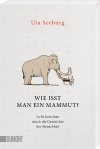Wie isst man ein Mammut?
In 50 Gerichten durch die Geschichte der Menschheit
256 pages
Dieser Titel ist in Ihrer lokalen Buchhandlung oder hier erhältlich:
UTA SEEBURG
Wie isst man ein Mammut?In 50 Gerichten durch die Geschichte der Menschheit/ How Would You Like Your Mammoth?The History of Humanity in 50 Dishes
ca. 256 pages with ca. 50 illlustrations
Spring 2023
English sample available
A culinary romp through 50 dishes that define human historyfrom prehistoric roasted mammoth to space-age dehydrated soup
[Uta Seeburg] brings the characters of history to life in fifty snackable essays . . . theamuse-bouche to a historical smorgasbord.
Max Miller,NEW YORK TIMESbestselling author ofTasting History
Reassuring readers that history isn't dull, colorless, or boring, Seeburg unquestionably captures our attention with these brief essays.
BOOKLIST
Serves up a culinary tour through history, beginning back when the unremarkable moochers known asHomo sapiensfed on scraps left behind by hyenas and saber-tooth tigers.THE WALL STREET JOURNAL
A concise masterclassin these deft and era-spanning essays, Uta Seeburg compresses a vast culinary history into a collection thats equal parts lively and illuminating.
Mayukh Sen,author ofTaste Makers
With her 50 stories full of concentrated knowledge and curiosities, Uta Seeburg delivers a feast served by the morsel for the palate interested in cultural history. A literary treat that leaves you wanting more!
Julian Hienstorfer, LITERATURE-COUCH.DE
If you could eat books, this one would melt in your mouth.
Sebastian Loskant, BREMER NACHRICHTEN
"[A] very instructive[s] and entertaining[s] book.
Daniela Zinser, WELT AM SONNTAG
"Uta Seeburg's book [is] full of anecdotes and insights.
Christoph Amend, ZEIT MAGAZIN
A Culinary History of Humanity
Did you know that the nobel citizens of Ancient Rome loved to watch live birds flutter out of a roasted piglets? Or that gladiators at the colosseum followed a vegan diet? How did the pickled herring come to be? And was the last mammoth really consumed in London in 1951?
Fifty dishes serve as touchstones for a history of food and humanity, too. Uta Seeburg takes fifty dishes and presents us with a chronological culinary history of humanity. From roasted mammoth (approx. 11,000 BC), to Babylonian stew (2000 BC), the last supper (approx. 30 AD), baked swan (1672), Wiener Schnitzel (around 1830) or Hawaiian toast (1955) to Ferran Adrias iconic liquid olives (2003): each essay describes a dish and why its creation marks a key moment in history. Learn what was eaten to celebrate the victory at Waterloo and how the omelette ended up on TV.
Rights sold to: Chongqing (Simplified Chinese); The Experiment (English World); Buchet Chastel (French); Corbacccio (Italian); Vison B & P (Korean); Frisk Forlag (Norwegian); Tima (Turkish);
Wie isst man ein Mammut?In 50 Gerichten durch die Geschichte der Menschheit/ How Would You Like Your Mammoth?The History of Humanity in 50 Dishes
ca. 256 pages with ca. 50 illlustrations
Spring 2023
English sample available
A culinary romp through 50 dishes that define human historyfrom prehistoric roasted mammoth to space-age dehydrated soup
[Uta Seeburg] brings the characters of history to life in fifty snackable essays . . . theamuse-bouche to a historical smorgasbord.
Max Miller,NEW YORK TIMESbestselling author ofTasting History
Reassuring readers that history isn't dull, colorless, or boring, Seeburg unquestionably captures our attention with these brief essays.
BOOKLIST
Serves up a culinary tour through history, beginning back when the unremarkable moochers known asHomo sapiensfed on scraps left behind by hyenas and saber-tooth tigers.THE WALL STREET JOURNAL
A concise masterclassin these deft and era-spanning essays, Uta Seeburg compresses a vast culinary history into a collection thats equal parts lively and illuminating.
Mayukh Sen,author ofTaste Makers
With her 50 stories full of concentrated knowledge and curiosities, Uta Seeburg delivers a feast served by the morsel for the palate interested in cultural history. A literary treat that leaves you wanting more!
Julian Hienstorfer, LITERATURE-COUCH.DE
If you could eat books, this one would melt in your mouth.
Sebastian Loskant, BREMER NACHRICHTEN
"[A] very instructive[s] and entertaining[s] book.
Daniela Zinser, WELT AM SONNTAG
"Uta Seeburg's book [is] full of anecdotes and insights.
Christoph Amend, ZEIT MAGAZIN
A Culinary History of Humanity
Did you know that the nobel citizens of Ancient Rome loved to watch live birds flutter out of a roasted piglets? Or that gladiators at the colosseum followed a vegan diet? How did the pickled herring come to be? And was the last mammoth really consumed in London in 1951?
Fifty dishes serve as touchstones for a history of food and humanity, too. Uta Seeburg takes fifty dishes and presents us with a chronological culinary history of humanity. From roasted mammoth (approx. 11,000 BC), to Babylonian stew (2000 BC), the last supper (approx. 30 AD), baked swan (1672), Wiener Schnitzel (around 1830) or Hawaiian toast (1955) to Ferran Adrias iconic liquid olives (2003): each essay describes a dish and why its creation marks a key moment in history. Learn what was eaten to celebrate the victory at Waterloo and how the omelette ended up on TV.
Rights sold to: Chongqing (Simplified Chinese); The Experiment (English World); Buchet Chastel (French); Corbacccio (Italian); Vison B & P (Korean); Frisk Forlag (Norwegian); Tima (Turkish);


